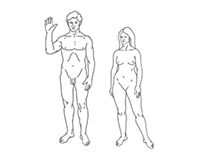Tetrahydrocannabinol [te-truh-hahy-druh-kuh-nab-uh-nawl] (THC), also known as delta-9-tetrahydrocannabinol (Δ9-THC), is the main chemical psychoactive substance found in the cannabis plant. It was first isolated in 1964. In pure form, it is a glassy solid when cold, and becomes viscous and sticky if warmed. An organic chemical (specifically an aromatic terpenoid), with very low solubility in water, but good solubility in most organic solvents (e.g. alcohol, acetone, and butane).
Like most pharmacologically-active plants, THC in cannabis is assumed to be involved in self-defense, perhaps against herbivores. THC also possesses high UV-B absorption properties, which, it has been speculated, could protect the plant from harmful UV radiation exposure. Dronabinol is the generic name of a THC isomer (it has the same number and type of atoms as THC but in a different configuration); it is sold as Marinol (a registered trademark of Solvay Pharmaceuticals).
The pharmacological actions of THC result from its binding to the cannabinoid receptor CB1, located mainly in the central nervous system, and the CB2 receptor, mainly present in cells of the immune system. It acts as a partial agonist on both receptors; i.e., it activates them but not to their full extent. The psychoactive effects of THC are mediated by its activation of the CB1 receptor, which is abundant in the brain. The presence of these specialized receptors implied to researchers that endogenous cannabinoids are manufactured by the body, so the search began for a substance normally manufactured in the brain that binds to these receptors, leading to the eventual discovery of several endocannabinoids. This is similar to the story of the discovery of endogenous opiates (endorphins), after the realization that morphine and other opiates bind to specific receptors in the brain. In addition, it has been shown that cannabinoids, through an unknown mechanism, activate endogenous opioid pathways involving an opioid receptor, precipitating a dopamine release in the nucleus accumbens a reward center in the brain.
The effects of the drug can be suppressed by the CB1 cannabinoid receptor antagonist rimonabant as well as opioid receptor antagonists (opioid blockers) naloxone and naloxonazine.
THC has mild to moderate analgesic (painkilling) effects. The mechanism for analgesic effects caused directly by THC or other cannabinoid agonists is not fully understood. Other effects include relaxation; euphoria; altered space-time perception; alteration of visual, auditory, and olfactory senses; anxiety or relaxation; disorientation; fatigue; and appetite stimulation (colloquially known as ‘the munchies’). CB1 activity in the hunger centers in the hypothalamus increases the palatability of food when levels of a hunger hormone ghrelin increase prior to consuming a meal. After food is passed into the intestines, signaling hormones such as leptin are released, causing reduction in gastric emptying and transmission of satiety signals to the brain. Cannabinoid activity is reduced through the satiety signals induced by leptin release.
There has never been a documented human fatality from overdosing on tetrahydrocannabinol or cannabis in its natural form. However, the synthetic THC pill Marinol was cited by the FDA as being responsible for four deaths. Information about THC’s toxicity is derived from animal studies.
In the United States, Marinol is a Schedule III drug, available by prescription, considered to be non-narcotic and to have a low risk of physical or mental dependence. Efforts to get cannabis rescheduled as analogous to Marinol have not succeeded thus far, though a 2002 petition has been accepted by the DEA. As a result of the rescheduling of Marinol from Schedule II to Schedule III, refills are now permitted for this substance. Marinol has been approved in the treatment of anorexia in AIDS patients, as well as for nausea by patients undergoing chemotherapy, which has raised much controversy as to why natural THC is still a schedule I drug.
An analog of dronabinol, nabilone, is available commercially in Canada under the trade name Cesamet, manufactured by Valeant Pharmaceuticals. Cesamet has also received FDA approval and began marketing in the US in 2006; it is a Schedule II drug (high potential for abuse, but has a currently accepted medical use).
In 2005, Canadian authorities approved the marketing of Sativex (nabiximols), a mouth spray for multiple sclerosis patients, who can use it to alleviate neuropathic pain and spasticity. Sativex contains tetrahydrocannabinol together with cannabidiol. It is marketed in Canada by GW Pharmaceuticals, being the first cannabis-based prescription drug in the world (in modern times). In addition, Sativex received European regulatory approval in 2010.
Female cannabis plants contain more than 60 cannabinoids, including cannabidiol (CBD), thought to be the major anticonvulsant that helps multiple sclerosis patients; and cannabichromene (CBC), an anti-inflammatory, which may contribute to the pain-killing effect of cannabis.
It takes over one hour for Marinol to reach full systemic effect, compared to minutes for smoked or vaporized cannabis. Some patients accustomed to inhaling just enough cannabis smoke to manage symptoms have complained of too-intense intoxication from Marinol’s predetermined dosages. Many patients have said that Marinol produces a more acute psychedelic effect than cannabis, and it has been speculated that this disparity can be explained by the moderating effect of the many non-THC cannabinoids present in cannabis. For that reason, alternative THC-containing medications based on botanical extracts of the cannabis plant such as nabiximols are being developed.
Mark Kleiman, director of the Drug Policy Analysis Program at UCLA’s School of Public Affairs said of Marinol, ‘It wasn’t any fun and made the user feel bad, so it could be approved without any fear that it would penetrate the recreational market, and then used as a club with which to beat back the advocates of whole cannabis as a medicine.’ United States federal law currently registers dronabinol as a Schedule III controlled substance, but all other cannabinoids remain Schedule I, excepting synthetics like nabilone.
Since at least 1986, the trend has been for THC in general, and especially the Marinol preparation, to be downgraded to less and less stringently-controlled schedules of controlled substances, in the U.S. and throughout the rest of the world.
The Daily Omnivore
Everything is Interesting




Leave a comment